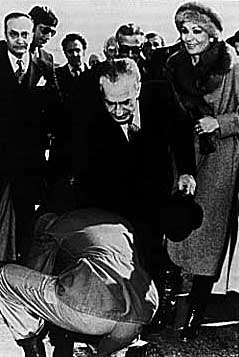Little fanfare on 20th anniversary of shah's flight
from Iran
 By Scheherezade Faramarzi
By Scheherezade Faramarzi
Jan 15, 1999, CAIRO, Egypt (AP) - Iran's imperial flag flutters rather
unmajestically next to the white-marbled tomb of Shah Mohammad Reza Pahlavi.
The lonely resting place of the shah of shahs - or king of kings - stands
in stark contrast to the grandeur he knew during his rule over Iran, which
ended 20 years ago Saturday.
A pitiful few pay homage at his
grave in a carpeted, domed chamber in the 18th century Rifai Mosque
in Islamic Cairo. The room is kept locked year-round; a caretaker opens
the door for visitors.
The shah is now very much history in his homeland. The majority of Iranians
were born after his 38-year-rule, and for most others, he's a distant memory.
The Islamic regime that ousted him isn't even bothering to mark the
anniversary of his exile. State radio and television plan only their customary,
brief documentaries on his departure. His supporters, scattered around
the world, do not want to look back at the humiliating demise of 2,500
years of monarchy.
"It's a bitter memory that we don't want to remember,'' said Ahmad
Oveissi, a spokesman for the shah's heir, Reza Pahlavi. He spoke from Virginia.
Reza, 38, said in a fax to The Associated Press that Iran suffered after
his father's departure.
"The people have paid a heavy price,'' he said. "What is important
is that my fellow countrymen emerge with their heads high and witness the
return of peace and prosperity in Iran.''
The shah and his wife, Empress Farah Diba, left Iran on Jan. 16, 1979,
as riots engulfed the country. Soon after, the revolution brought the Islamic
republic to power and the royal couple never returned.
Before leaving, a tearful shah knelt down and kissed the ground; he
took with him a handful of soil. News of his departure from Iran led to
an explosion of joy on the streets of the capital, Tehran.
"SHAH'S GONE,'' screamed banner headlines. Strangers embraced,
people danced and drivers flashed their headlights and honked their horns
incessantly. Shops gave away sweets and taxi drivers offered free rides.
Crowds cheered as statues of the shah and his father, Reza Shah, were
toppled. Revolutionary fervor and anti-American zeal culminated on Nov.
4, 1979, when Islamic students stormed the U.S. Embassy. They held 52 Americans
hostage for 444 days.
Meanwhile, the shah and Farah wandered from one retreat to another -
Egypt, Morocco, the Bahamas, Mexico, the United States and Panama - unable
to find a friendly host. "The world is cruel to losers,'' Farah, 59,
said in a Lebanese television interview in November.
The shah died in Egypt at age 60, 1 1/2 years after leaving Iran. He
spent his last lonely days in exile there, shunned by most world leaders
and his own people. In Iran, some elderly Iranians unhappy with the poor
economy and the strict Islamic rules speak nostalgically of the days of
wealth during the monarchy.
"I think the shah wasn't so bad,'' said Kaykavoos, who refused
to give his full name. The young, who do not remember the shah's despotic
rule, see no use in looking back.
"The shah is dead,'' said Kiyumars Mehrabi, 21. "That's it.''
Links


![]()